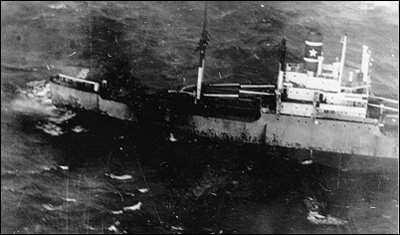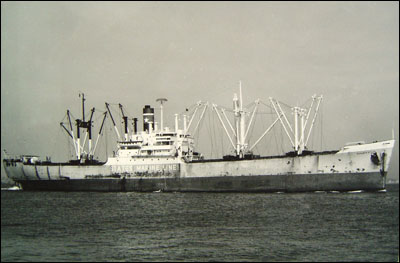| Gross Tonnage: | 8,166 | Net: | 4,837 |
| Dimensions: | 459.1 x 63.2 x 28.6 7/8 | MC Type: | C2-S-AJ1 |
| Builder: | North Carolina Shipbuilding Co.
Wilmington, NC | Hull #
USMC Hull #
Date of Build:
Delivered: | 103
1358
1944
2/44 |
| Engines: | 2 Steam Turbines DR Geared to Single Screwed Shaft | Engine Builder: | General Electric Co.
Lynn, MA |
| Navigation: | DF, ESD, GC, PFD, RDR | Decks, etc.: | 3 Decks, Electrically Welded |
| Began SM Service: | 1960 | Ended SM Service: | 1970 |
----------------------------------- Vessel History ----------------------------------- |
Date | Vessel
# | Vessel
Name | Vessel
Owner | Call Ltrs | Home
Port | Flag |
1944 | AP 175 | USS Starlight | US Navy | | | US |
1946 | | USS Starlight | US Maritime Commission | | | US |
1948 | 245136 | Florence Luckenbach | Luckenbach Steamship Co.
New York & Philadelphia, PA | KWGE | New York | US |
1960 | 245136 | Badger State | States Marine Lines, Inc. (DE)
New York | KWGE | New York | US |
Events:
3/44: Completed conversion to a transport (1,575 troops) by Bethlehem Steel Co., Staten Island for operation by US Navy (AP 175).
1946: U.S. Maritime Commission
1948: Sold to Luckenbach Steamship Co., renamed FLORENCE LUCKENBACH.
1960: Sold to States Marine Lines, renamed BADGER STATE.
| Disposition Date | Comments |
| 1970 | 12/26/69: Abandoned in Pacific after explosion in cargo.
1/5/70: Sank 40.11.06 N, 167.46.2 W, about 1,500 mi NW of Hawaii.
U.S government investigators who inquired into the explosion on the BADGER STATE criticised the procedure used to stow bombs on board. They described a horror story in the north Pacific in which a bomb broke loose in the hold of the ship, exploded and sank the vessel in a raging gale when 550 mi. from Midway Island and bound for Vietnam, after having loaded ammunition at Bangor, WA.
The crew fought for 9 days to steady the cargo and several times changed the course in attempts to find calm seas. But with each roll of the ship the bombs rolled or slid, striking each other or the ship's steel hull where wood sheathing had been splintered away. Small holes were punched in the ship's side by the battering action of the bombs. Several fell into the hold below through the 'tween deck hatch where the boards had been carried away.
Finally one of the bombs exploded when it was jarred, and fire swept the ship. The explosion was well below its potential force, failing to set off other bombs, but it blew a hole 12 feet x 8 feet in the ship's side. The ship was abandoned, but the wind blew away 2 life rafts. The crew managed to launch another and 35 of them scrambled aboard, but before it could pull away, a 2,000 lb bomb rolled out of the hole in the side of the ship and capsized the raft.
A cargo ship arrived on the scene soon after, but only a few of the crew were saved. Many of those lost clung to heaving lines, nets and ladders from the ship and were hauled almost to deck level before they were washed away by 30 ft. seas. Albatrosses attacked the men fighting to survive in the 48 degree water.
The report criticised the stowage of the bombs on the ship, particularly the vulnerability to impact of the metal bands used to secure the bombs to cargo pallets and the manner in which wooded blocks had been used to wedge the cargo against the hull.
The hulk of the ship remained afloat and drifting, still afire and undergoing further explosions, for 10 days. A Navy tug was at the scene, the situation was considered hazardous and it was decided to sink the ship by gunfire. But she sank due to a combination of explosion damages and heavy weather before gunfire could commence. |
|

 Photo courtesy of
William R. Benedetto © 2005 - All rights reserved.
Photo courtesy of
William R. Benedetto © 2005 - All rights reserved.